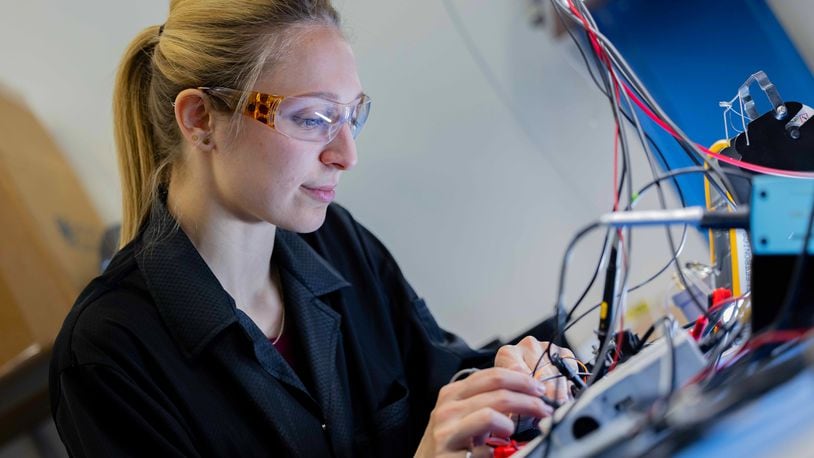Combined with last year’s announcement of up to $20 million for new test cell and equipment at its EPISCenter in downtown Dayton, that represents a $53.7 million investment in the past two years.
“As we prepare and position ourselves for growth ahead, we continue to invest in southwest Ohio in both the Dayton area and around our headquarters in the Cincinnati area,” said spokeswoman Chelsey Levingston. “Southwest Ohio is very much central to GE Aerospace’s growth for the future and Southwest Ohio ... and the Dayton area is also central to the aviation industry and to inventing the future of flight.”
The company’s Dayton area investments over the past two years include opening a new production facility on Research Boulevard in Beavercreek to manufacture jet engines, gas turbine tubes, ducts and fuel manifolds. It also has complex machining, fabrication and investment casting capabilities.
Product engineering, new product development and testing is performed on site. The facility also does repair and overhaul of tubes, ducts, and manifolds.
Construction of the facility, with its 240,000 square feet of manufacturing space and 40,000 square feet of office space, allowed GE Aerospace to consolidate five separate local facilities into one location, according to Brian De Bruin, plant leader.
“Before, (when there were multiple locations), someone had to get in the car, take the part with them, head back to the machine shop, show them what was going on and try to do problem solving,” De Bruin said. “Now, we can bring the machinist to the assembly shop and say ‘Look, what do you think? Here’s what we’re seeing. How’s it look like when you’re doing it?’ and we can solve those problems real time.”
GE Aerospace held an opening ceremony for the Beavercreek facility last May, the same week it announced it would invest up to $20 million into its 138,000-square-foot downtown Dayton EPISCenter, to build a new test cell to test hybrid electric engines.
That investment brings to nearly $100 million the amount that has been invested into the facility since it opened on the University of Dayton campus in December 2013, officials said.
The facility develops electrical power systems for aircraft and engines.
“One of the key things in enabling the future flight is that there’s a big focus on electrification in aerospace overall, be that your mission loads in a military application or be it for hybrid electric being introduced for propulsion to drive more sustainability in the industry,” said EPISCenter leader Joe Krisciunas, president and general manager of electrical power systems for GE Aerospace. “By putting the capabilities here in Dayton, when we invested in the Electrical Power Integrated Systems Center (EPISCenter) here a decade ago, we really positioned ourselves well to be the location for development testing of those new technologies.”
Krisciunas said an aircraft has a lot of components that are electrical and constitute its “smart grid.”
“You have to generate (and) control power and distribute it effectively and make sure it’s safe and reliable and so it’s equivalent to the electrical grid on the ground,” he said. “We do that in the air and we design, develop and test those systems for that electrical grid at the EPISCenter.”
As other industries include electrification in their products, such as the automotive industry, where hybrid and electric vehicles have emerged as sustainable alternatives, GE Aerospace is looking at applying them in its aviation and propulsion systems.
Krisciunas said GE’s EPISCenter has won both civil and military contracts in the past decade, building up the site’s capability.
“When we opened it in 2013, it was a large building, largely a shell ... (and) we build up the test capabilities, we’ve adapted the technology, and now we can take on that bigger project and it’s just been a virtuous cycle.”
Last Tuesday, GE Aerospace announced plans to invest $650 million in 2024 in its supply chain, including facility, tooling and equipment upgrades. That includes $127 million across Ohio. Dayton-area locations in Beavercreek and Vandalia on Poe Avenue expect to receive $19.9 million to go towards new manufacturing equipment.
De Bruin said the Dayton region is a key part of GE Aerospace’s footprint and the company is investing in its manufacturing base so that it can continue to support future development.
He said the company’s purpose statement is “We invent the future of flight, lift people up, and bring them home safely.”
“It’s kind of the way we think about the business (and) we’re working on new technologies in the Dayton region that will support (GE Aerospace),” De Bruin said. “”We’ve got demonstrated technical know-how, and, and we’re a reliable partner.”
In addition to the new facility in Beavercreek and the EPISCenter in Dayton, other GE Aerospace area sites include:
- Dayton Cores & Castings at 2060 Heller Drive in Beavercreek, a 150,000-square-foot facility that makes high-pressure turbine airfoil cores and castings.
- TDI at 6800 Poe Ave. in Vandalia, a 105,000-square-foot facility that opened in 1958 and makes industrial air starters.
- GE Aviation Vandalia at 740 E. National Road in Vandalia, a 144,000-square-foot facility, which opened in 1948 and joined GE Aerospace through a 2007 acquisition. It produces electrical power generators.
Together, GE’s Dayton area sites employ 1,400 people, officials said.
About the Author
